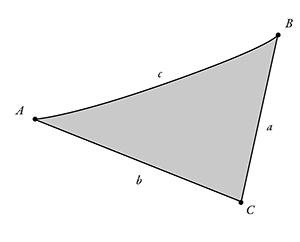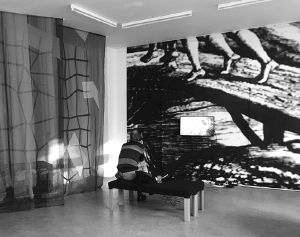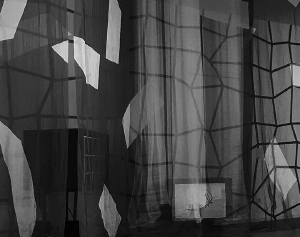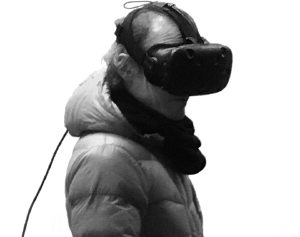Michelle Atherton, Jette Gejl, TC McCormack
spor klübü
2019:September //
For the english version please scroll down!
Beim Betreten von Matthias Mayers „Spor Klübü“-Raum in Berlin-Wedding war klar, dass es der Besucher mit einer „anderen Grammatik“ zu tun haben würde. Das erfordert einige Anstrengungen, ist aber gut für das Gehirn. Es ist, als würde man eine andere Sprache sprechen, oder einen Dialekt. Es ist die zweite Show, die von TC McCormack hier in den letzten Jahren kuratiert wurde, letztes Mal war er der einzige Kurator, diesmal teilt er sich die Aufgabe mit Michelle Atherton und Jette Gejl, seinen aktuellen Mitausstellerinnen von „It doesn’t have a Shape, it has a Shadow“.
Die Arbeiten der Künstler bilden ein schräges Dreieck im Raum. Mehr oder weniger wie dieses hellgraue links.
Die Linie c ist aber nicht gerade, sondern bildet eher einen Bogen. Jette Geil befindet sich am Punkt A, TC McCormacks Vorhang bedeckt einen Teil der Rückwand vom Eingang aus, dahinter stehen zwei Barco-Monitore, die einen Feed mit verschiedenen Texturen und Farben anzeigen, McCormack, der verschiedene Muster und ihre charakteristischen Akzente verwendet, als ob er einen alten Synthesizer spielt. Und die Noten werden durch ihre Rekontextualisierung verklärt.
Auf der Linie a befindet sich der Screening-Punkt für Athertons ebenso immersive Videoarbeit.
Kurzanalyse:
Bereits die Verwendung von Vorhängen und anderen Stoffmaterialien zur Aufteilung des Raumes, die wir als Zeichen für das Interesse an Tragkonstruktionen und Ausstellungsgestaltung erkennen. Lilly Reich war der erste Gedanke.
Aber stattdessen zitiert man aus dem Handout der Ausstellung:
„Die meisten Geschichten haben eine Form zu ihnen, nun, diese Geschichte hat keine Form, aber sie hat einen Schatten. Wir könnten versuchen, den Schatten (davon) zu beschreiben, aber bis wir am Ende angelangt sind …wird sich die Sonne verschoben haben und die Dimensionen des Schattens der Geschichte werden eine geometrische Perversion dessen sein, was sie am Anfang waren.“
Eine andere Grammatik. Aber es ist grammatikalisch plausibel, dass Geschichten eine Art Schatten haben könnten, vielleicht einen Windschatten. Es könnte etwas sein, dem wir noch nicht begegnet sind. Vielleicht ein ultravioletter Schatten. Aber obwohl es nicht (absichtlich) gescannt wird und es schwer vorstellbar ist, wie eine Geschichte einen Schatten haben kann, akzeptieren Sie bitte die Hypothese vorerst. Es ist nicht immer gut, wenn der Kunstdiskurs sein Vokabular erweitert, aber hier gibt es Gefühle. Oder ist es eher eine existentielle Schlussfolgerung? Der schreckliche Schatten der Existenz? Das verdunkelt unsere missliche Lage? Nein. Der Titel hat etwas Wahres an sich. Die Grammatik des Textes besteht darauf, dass es um Grammatik geht, nicht um Existenz. Zwei sehr unterschiedliche Dinge. Grammatik wird verwendet, um eine Erzählung nachzuerzählen. Eine künstliche Erzählung aus dem Fluss des Lebens, die von nicht-grammatischer Natur ist. Und der Schatten ändert sich, wie Sie ihn beschreiben, eher wie ein Live-Feed. Was wirft also einen Schatten, könnte sich der Besucher fragen, wenn er Matthias Mayers „Spor Klübü“-Raum in Berlin Wedding betritt.
Der Biologe Stuart Kauffman spricht in der Pressemitteilung von dem, „what he calls the adjacent possible“. Sitzen auf der Bank, die dann angrenzend verläuft.
Sicherlich könnte der Besucher mit den Kopfhörern schweigend mit Michelle Athertons Werk kommunizieren:
„… situiert in einer Landschaft, einem Blow-up einer C16-Gravur, die intermittierend von farbigen Lichtern beleuchtet wird, bringt RIGs # IIII eine neue dissonante Sequenz von irrationalen Gesten zusammen, die sich entwickeln und über die Dauer des Videos aufeinandertreffen. Wenn wir uns darauf einigen können, dass das Irrationale jene Handlungen, Gedanken und Verhaltensweisen beschreibt, die unlogischer erscheinen als andere Alternativen; dann eröffnet das Kunstwerk einen Raum, um vergangene und gegenwärtige Konzeptualisierungen von Irrationalität zu betrachten.
Mit Beiträgen von Anita Delaney, Jessica Harrington, Dr. Wendy Leeks und Lucy Lound.“
Dann behalte das in Deinem Kopf und befrage (zur gleichen Zeit) TC McCormack
„Alle unsere Schiffe sind auf See.
Eine geloopte Audioarbeit, mit Video-Diptychon, einem Wandmuster, aufgehängten Stoffdrucken und einer Reihe von Bildern. In der Mitte dieser Assemblage befindet sich ein gesprochener Text, in dem die Stimmen von einer divergierenden Fragmentierung, einem Verstellen und von einer Verschiebung sprechen. Ebenso verweist die Bildsprache auf ein ungreifbares Verrutschen von Inhalten. Die Bilder adaptieren ausweichende optische Register, die aus einer Stealth-Technologie und topologischen Merkmalen stammen. Die räumlichen Qualitäten der gemusterten Oberfläche mit den zeitlichen Bedingungen des Klangs in den Vordergrund zu stellen, ermöglicht es, sich von konventionelleren Erzählstrukturen zu lösen und eine immersivere und intimere Umgebung zu erkunden.“
Den Vorhang, der auch grob an die Rückwand angrenzt, entlang gleitend, weigert sich der Blick, sich zu beruhigen. Dann Kopfhörer aus, aufstehen und parallel zur Rückwand rutschen. In Reichweite, von der Intervention des Vorhangs verdeckt, sind sehr regelmäßige, handgeklebte Muster an der Rückwand. Erleben Sie die Statik des aufgeklebten Musters von TC McCormack an der Wand, hinter diesem Vorhang, verkleidetes Design, überschrieben durch die Wirkung des Vorhangs vor ihm, der sich ständig aufs Herrlichste verändert, seine kitschigen Muster aus den 1980er-Jahren kaleidoskopartig auf die Netzhautebene hinaus verlängert.
Und das gilt auch für Jette Gejl:
„Ich mag Beige und Beige mag mich.
Dieses Werk bietet eine Neuinterpretation des Joseph Beuys-Stückes ’I like America and America likes me’ und versucht, die kollektive Hysterie um das Unbekannte zu heilen. Die Arbeit besteht aus der VR-Arbeit ’Beige Space’, die mit einem kopfmontierten Display, einem Poster mit DNA-Kartierung der beiden Wolfsarten ’Canis Latrans – Canis Lupu’, einem Sockel mit dem kalkhaltigen Ton ’Mergel’ und einem Text erlebbar ist.“
Alle Zitate wurden vom Autor vom Englischen ins Deutsche übersetzt!
English Version
Entering Matthias Mayer’s Spor Klübü space in Berlin Wedding, it was clear the visitor would have to deal with a different grammar. That takes some effort, but it’s good for the brain. It’s like speaking another language, or sub-dialect. It’s the second show curated by TC McCormack here in the last few years, last time he was the sole curator, this time he shares the task with Michelle Atherton and Jette Gejl, his co-exhibitors in “It doesn’t have a Shape, it has a Shadow.”
The artists’ works form an oblique triangle in the space. More or less like this pastel green one.
The line c is not straight, more of a bow. Jette Geil is situated at point A, TC McCormack’s curtain covers part of the back wall from the entrance, behind it two Barco monitors display a feed of different textures and colours, McCormack utilizing different patterns and their particularising accents as if playing an ancient synthesizer. The notes are transfigured by their recontextualization.
On the line a is the screening point for Atherton’s equally immersive video work.
Short Analysis:
Already the use of curtains and other cloth materials to divide the space we recognise as signifying interest in support structures and exhibition design. Lilly Reich was the first thought.
But quoting instead from the exhibition handout:
“Most stories have a shape to them, well this story doesn’t have any shape, but it does have a shadow. We could try to describe the shadow (of it), but by the time we get to the end... the sun will have shifted position and the dimensions of the story’s shadow will be a geometric perversion of what they were at the start.”
A different grammar. But it is grammatically plausible that stories might have a type of shadow, perhaps a wind shadow. It might be something we haven’t encountered yet. Perhaps an ultra violet shadow. But although it doesn’t scan (deliberately) and it’s hard imagining how a story can have a shadow, please accept the hypothesis for now. It’s not always good when art discourse extends its vocabulary but there is feeling here. Or is it more of an existential conclusion? The dire shadow of existence? That darkens our predicament? No. The title has a truth to it. The text’s grammar insists that it is about grammar, not existence. Two very different things. Grammar is used to recount a narrative. An artificial narrative taken from the flow of life, which is ungrammatical in nature. And the shadow changes as you are describing it, rather like a live feed. So, what casts a shadow? the visitor might think entering Matthias Mayer’s Spor Klübü space in Berlin Wedding.
Now sitting down on the bench running parallel to line a. The biologist Stuart Kauffman speaks in the press release of what he calls the adjacent possible. Sitting on the bench running adjacent then.
Certainly with the headphones the visitor could commune in silence for Michelle’s work: “in a landscape, a blow-up of a C16 engraving intermittently illuminated by coloured lights, RIG’s # IIII brings together a new dissonant sequence of irrational gestures that evolve and are clashed together over the duration of the video. If we can agree that the irrational describes those actions, thinking and behaviours that appear to be more illogical than other alternatives; then, the artwork opens up a space to consider past and present conceptualisations of irrationality.
With contributions from Anita Delaney, Jessica Harrington, Dr Wendy Leeks and Lucy Lound.”
Then hold that in your head and consider (at the same time)
TC McCormack
“All our Ships are at Sea
A looped audio work, with video diptych, a mural pattern, suspended fabric prints and set of images.
At its centre, this assemblage features a spoken text, where voices speak of a divergent fragmentation, a dissembling and of displacement. Likewise, the visual language alludes to an ungraspable slippage of content. The imagery adapts evasive optical registers, drawn from a stealth technology and topological features. Foregrounding the spatial qualities of patterned surface with the temporal conditions of sound, enables a move away from more conventional narrative structures to explore a more immersive and intimate environment.”
Gliding along the curtain also roughly adjacent to the back wall. Gaze refuses to settle. Headphones off, get up and slide parallel with the back wall. Reaching out, submerged by the curtain’s intervention are very regular hand taped patterns on the back wall. Perceive the stasis of TC’s taped pattern on the wall, behind this curtain, design in disguise, overwritten by the action of the curtain in front of it which is gloriously ever changing, its 1980s kitsch patterns kaleidoscope-ing out to the retinal plane. So in a sense the exhibition is very much about claiming the space in the viewer’s head, for one thing. Sliding across the back of the space was helped by optical effects that kept me interested.
And so to Jette Gejl:
“I like beige and beige likes me
This work offers a reinterpretation of Joseph Beuys piece ‘I like America and America likes me’ and seeks to heal collective hysteria surrounding the unknown. The work consists of the VR work ‘Beige Space’ which can be experienced using a head mounted display, a poster with DNA mapping of the two wolf species ‘Canis Latrans - Canis Lupus’, a plinth with the calcareous clay ‘Mergel’ and a text.”
Michelle Atherton, Jette Gejl, TC McCormack
„It doesn’t have a Shape, it has a Shadow“, Spor Klübü,
Freienwalder Straße 31, 13359 Berlin, 30. März–12. April 2019

Schräges Dreieck


“It doesn’t have a Shape, it has a Shadow“, Ausstellungsansichten Spor Klübü

“It doesn’t have a Shape, it has a Shadow“